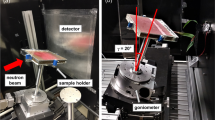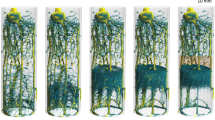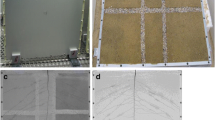Abstract
Purpose
The rooted zone of a soil, more precisely the rhizosphere, is a very dynamic system. Some of the key processes are water uptake and root respiration. We have developed a novel method for measuring the real-time distribution of water and oxygen concentration in the rhizosphere as a biogeochemical interface in soil. This enables understanding where and when roots are active in respect to root respiration and water uptake and how the soil responds to it.
Materials and methods
We used glass containers (15 × 15 × 1 cm), which were filled with a quartz sand mixture. Sensor foils for fluorescence dye imaging of O2 were installed on the inner side of the containers. A lupine plant was grown in each container for 2 weeks under controlled conditions. Then we took time series of fluorescence images for time-lapsed visualization of oxygen depletion caused by root respiration. Changing water content was mapped in parallel by non-invasive neutron radiography, which yields water content distributions in high spatial resolution. Also it can detect the root system of the lupine plants. By this combined imaging of the samples, a range of water contents and different oxygen concentration levels, both induced by root activities, could be assessed.
Results and discussion
We monitored the dynamics of these vital parameters induced by roots during a period of several hours. We observed that for high water saturation, the oxygen concentration decreased in parts of the container. The accompanying neutron radiographies gave us the information that these locations are spatially correlated to roots. Therefore, it can be concluded that the observed oxygen deficits close to the roots result from root respiration and show up while re-aeration from atmosphere by gas phase transport is restricted by the high water saturation.
Conclusions
Our coupled imaging setup was able to monitor the spatial distribution and temporal dynamics of oxygen and water content in a night and day cycle. This reflects complex plant activities such as photosynthesis, transpiration, and metabolic activities impacting the root–soil interface. Our experimental setup provides the possibility to non-invasively visualize these parameters with high resolution. The particular oxygen imaging method as well as the combination with simultaneously mapping the water content by neutron radiography is a novelty.







Similar content being viewed by others
References
Amao Y, Okura I (2000) An oxygen sensing system based on the phosphorescence quenching of metalloporphyrin thin film on alumina plates. Analyst 125:1601–1604
Bacon JR, Demas JN (1987) Determination of oxygen concentrations by luminescence quenching of a polymer-immobilized transition-metal complex. Anal Chem 59:2780–2785
Balcke GU, Meenken S, Hoefer C, Oswald SE (2007) Kinetic gas–water transfer and gas accumulation in porous media during pulsed oxygen sparging. Environ Sci Technol 41:4428–4434
Baleizão C, Nagl S, Schaferling M, Berberan-Santos MN, Wolfbeis OS (2008) Dual fluorescence sensor for trace oxygen and temperature with unmatched range and sensitivity. Anal Chem 80:6449–6457
Blossfeld S, Gansert D (2007) A novel non-invasive optical method for quantitative visualization of pH dynamics in the rhizosphere of plants. Plant Cell and Environment 30:176–186
Blossfeld S, Gansert D, Thiele B, Kuhn AJ, Lösch R (2011) The dynamics of oxygen concentration, pH value, and organic acids in the rhizosphere of Juncus spp. Soil Biology Biochemistry 43:1186–1197
Borisov SM, Vasylevska AS, Krause C, Wolfbeis OS (2006) Composite luminescent material for dual sensing of oxygen and temperature. Advanced Functional Materials 16:1536–1542
Brune A, Frenzel P, Cypionka H (2000) Life at the oxic–anoxic interface: microbial activities and adaptations. Fems Microbiol Rev 24:691–710
Carminati A, Fluhler H (2009) Water infiltration and redistribution in soil aggregate packings. Vadose Zone J 8:150–157
Carraway ER, Demas JN, Degraff BA (1991a) Luminescence quenching mechanism for microheterogeneous systems. Anal Chem 63:332–336
Carraway ER, Demas JN, DeGraff BA, Bundt M (1991b) Photophysics and photochemistry of oxygen sensors based on luminescent transition-metal-complexes. Anal Chem 63:337–342
Deinert MR, Parlange JY, Steenhuis T, Throop J, Unlu K, Cady KB (2004) Measurement of fluid contents and wetting front profiles by real-time neutron radiography. J Hydrol 290:192–201
Demas JN, Degraff BA, Xu WY (1995) Modeling of luminescence quenching-based sensors—comparison of multisite and nonlinear gas solubility models. Anal Chem 67:1377–1380
Donaldson JH, Istok JD, Humphrey MD, OReilly KT, Hawelka CA, Mohr DH (1997) Development and testing of a kinetic model for oxygen transport in porous media in the presence of trapped gas. Ground Water 35:270–279
Esser HG, Carminati A, Vontobel P, Lehmann EH, Oswald SE (2010) Neutron radiography and tomography of water distribution in the root zone. J Plant Nutr Soil Sci 173(5):757–764
Fuller ZJ, Bare WD, Kneas KA, Xu WY, Demas JN, DeGraff BA (2003) Photostability of luminescent ruthenium(II) complexes in polymers and in solution. Anal Chem 75:2670–2677
Glud RN, Ramsing NB, Gundersen JK, Klimant I (1996) Planar optrodes: A new tool for fine scale measurements of two-dimensional O-2 distribution in benthic communities. Mar Ecol-Prog Ser 140:217–226
Glud RN, Santegoeds CM, De Beer D, Kohls O, Ramsing NB (1998) Oxygen dynamics at the base of a biofilm studied with planar optodes. Aquatic Microbial Ecology 14:223–233
Hassanein RK (2006) Correction methods for the quantitative evaluation of thermal neutron tomography. Dissertation, ETH Zurich
Hinsinger P, Bengough AG, Vetterlein D, Young IM (2009) Rhizosphere: biophysics, biogeochemistry and ecological relevance. Plant Soil 321:117–152
Huang WE, Oswald SE, Lerner DN, Smith CC, Zheng C (2003) Dissolved oxygen imaging in a porous medium to investigate biodegradation in a plume with limited electron acceptor supply. Environ Sci Technol 37:1905–1911
Jensen SI, Kuhl M, Glud RN, Jorgensen LB, Prieme A (2005) Oxic microzones and radial oxygen loss from roots of Zostera marina. Mar Ecol-Prog Ser 293:49–58
Kardjilov N, Hilger A, Manke I, Strobl M, Treimer W, Banhart J (2005) Industrial applications at the new cold neutron radiography and tomography facility of the HMI. Nucl Instrum Meth A 542:16–21
Klimant I, Meyer V, Kuhl M (1995) Fiberoptic oxygen microsensors, a new tool in aquatic biology. Limnol Oceanogr 40:1159–1165
Lehmann E, Pleinert H, Williams T, Pralong C (1999) Application of new radiation detection techniques at the Paul Scherrer Institut, especially at the spallation neutron source. Nucl Instrum Meth A 424:158–164
Liebsch G, Klimant I, Wolfbeis OS (1999) Luminescence lifetime temperature sensing based on sol–gels and poly(acrylonitrile)s dyed with ruthenium metal-ligand complexes. Advanced Materials 11:1296–1299
Liebsch G, Klimant I, Frank B, Holst G, Wolfbeis OS (2000) Luminescence lifetime imaging of oxygen, pH, and carbon dioxide distribution using optical sensors. Applied Spectroscopy 54:548–559
Luster J, Gottlein A, Nowack B, Sarret G (2009) Sampling, defining, characterising and modeling the rhizosphere—the soil science tool box. Plant Soil 321:457–482
Matsushima U, Herppich WB, Kardjilov N, Graf W, Hilger A, Manke I (2009) Estimation of water flow velocity in small plants using cold neutron imaging with D2O tracer. Nucl Instrum Meth A 605:146–149
Mills A, Lepre A (1997) Controlling the response characteristics of luminescent porphyrin plastic film sensors for oxygen. Anal Chem 69:4653–4659
Moradi AB, Conesa HM, Robinson B, Lehmann E, Kuehne G, Kaestner A, Oswald S, Schulin R (2009) Neutron radiography as a tool for revealing root development in soil: capabilities and limitations. Plant Soil 318:243–255
Moradi AB, Carminati A, Vetterlein D, Vontobel P, Lehmann E, Weller U, Vogel HJ, Oswald SE (2011) Three-dimensional visualization and quantification of water content in the rhizosphere. New Phytol. doi:10.1111/j.1469-8137.2011.03826.x
Nagl S, Wolfbeis OS (2007) Optical multiple chemical sensing: status and current challenges. Analyst 132:507–511
Nagl S, Baleizao C, Borisov SM, Schaferling M, Berberan-Santos MN, Wolfbeis OS (2007) Optical sensing and imaging of trace oxygen with record response. Angew Chem Int Edit 46:2317–2319
Oswald SE, Menon M, Carminati A, Vontobel P, Lehmann E, Schulin R (2008) Quantitative imaging of infiltration, root growth, and root water uptake via neutron radiography. Vadose Zone J 7:1035–1047
Precht E, Franke U, Polerecky L, Huettel M (2004) Oxygen dynamics in permeable sediments with wave-driven pore water exchange. Limnol Oceanogr 49:693–705
Schreiber C (2010) Rhizosphere dynamics of higher plants in the water fluctuation zone of Yangtze River: root exudates and mass flow. Dissertation, University Düsseldorf
Schroeder CR, Polerecky L, Klimant I (2007) Time-resolved pH/pO(2) mapping with luminescent hybrid sensors. Anal Chem 79:60–70
Strobl M, Manke I, Kardjilov N, Hilger A, Dawson M, Banhart J (2009) Advances in neutron radiography and tomography. J Phys D Appl Phys 42:243001. doi:10.1088/0022-3727/42/24/243001
Tournaire-Roux C, Sutka M, Javot H, Gout E, Gerbeau P, Luu DT, Bligny R, Maurel C (2003) Cytosolic pH regulates root water transport during anoxic stress through gating of aquaporins. Nature 425:393–397
Tumlinson LG, Liu H, Silk WK, Hopmans JW (2008) Thermal neutron computed tomography of soil water and plant roots. Soil Sci Soc Am J 72:1234–1242
Acknowledgments
We acknowledge funding from the DFG priority program 1315 “Biogeochemical interfaces in soil”, under contract OS 351/1-2, and the support from the Helmholtz Centre for Environmental Research—UFZ, departments Hydrogeology and Soil Physics.
Author information
Authors and Affiliations
Corresponding author
Additional information
Responsible editor: Michael Kersten
Rights and permissions
About this article
Cite this article
Rudolph, N., Esser, H.G., Carminati, A. et al. Dynamic oxygen mapping in the root zone by fluorescence dye imaging combined with neutron radiography. J Soils Sediments 12, 63–74 (2012). https://doi.org/10.1007/s11368-011-0407-7
Received:
Accepted:
Published:
Issue Date:
DOI: https://doi.org/10.1007/s11368-011-0407-7




